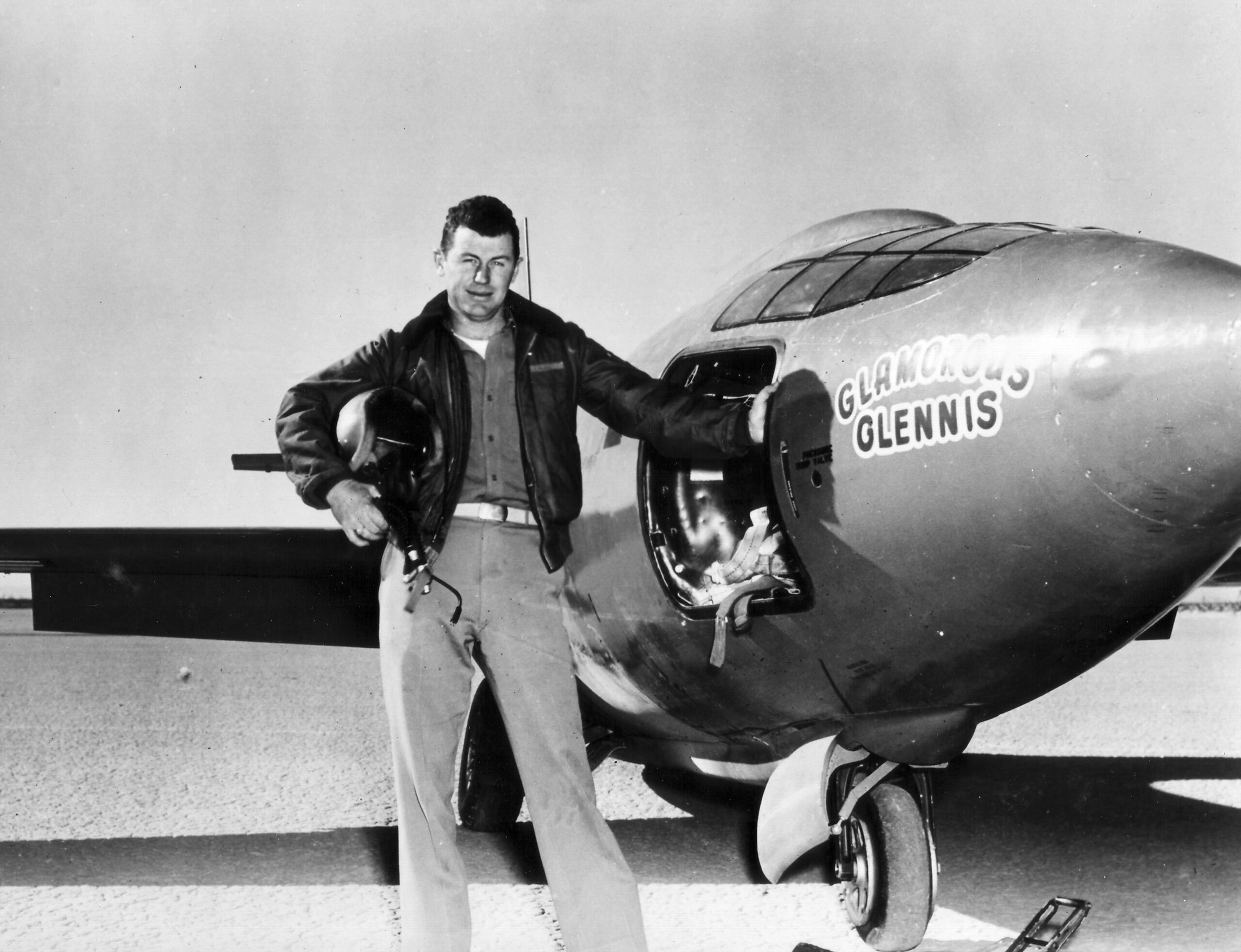
14 October 1947: At approximately 10:00 a.m., a four-engine Boeing B-29 Superfortress heavy bomber, piloted by Major Robert L. Cardenas, took off from Muroc Air Force Base (now known as Edwards Air Force Base) in the high desert north of Los Angeles, California. The B-29’s bomb bay had been modified to carry the Bell XS-1, a rocket-powered airplane designed to investigate flight at speeds near the Speed of Sound (Mach 1).
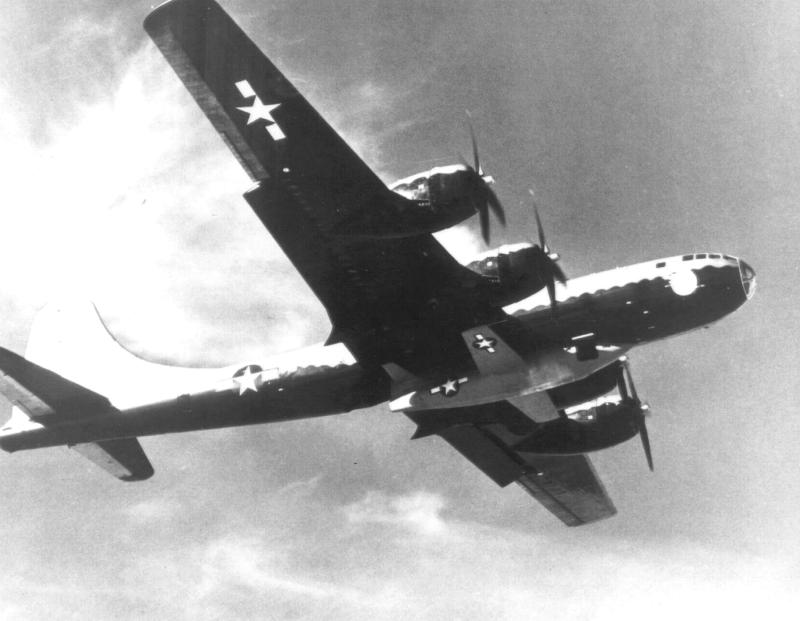
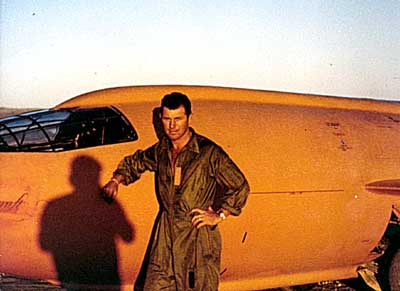
Air Force test pilot Captain Charles Elwood (“Chuck”) Yeager, a World War II fighter ace, was the U.S. Air Force pilot for this project. The X-1 airplane had been previously flown by company test pilots Jack Woolams and Chalmers Goodlin. Two more X-1 aircraft were built by Bell, and the second, 46-063, had already begun its flight testing.
Captain Yeager had made three glide flights and this was to be his ninth powered flight. Like his P-51 Mustang fighters, he had named this airplane after his wife, Glamorous Glennis.
Bob Cardenas climbed to 20,000 feet (6,096 meters) and then put the B-29 into a shallow dive to gain speed. In his autobiography, Yeager wrote:
“One minute to drop. [Jack] Ridley flashed the word from the copilot’s seat in the mother ship. . . Major Cardenas, the driver, starts counting backwards from ten. C-r-r-ack. The bomb shackle release jolts you up from your seat, and as you sail out of the dark bomb bay the sun explodes in brightness. You’re looking at the sky. Wrong! You should have dropped level. The dive speed was too slow, and they dropped you in a nose-up stall. . .
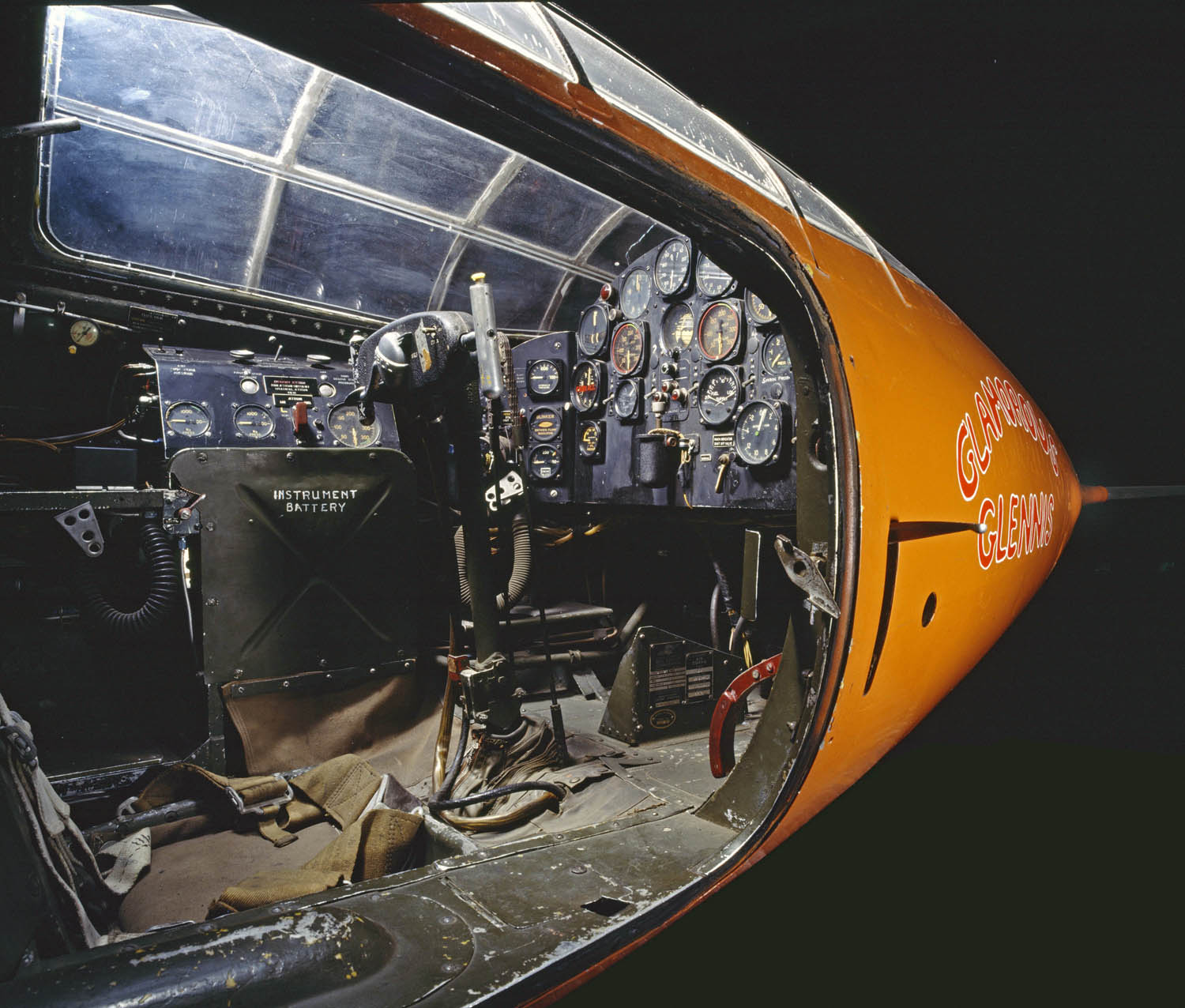
“I fought it with the control wheel for about five hundred feet, and finally got her nose down. The moment we picked up speed I fired all four rocket chambers in rapid sequence. We climbed at .88 Mach. . . I turned off two rocket chambers. At 40,000 feet, we were still climbing at .92 Mach. Leveling off at 42,000 feet, I had thirty percent of my fuel, so I turned on rocket chamber three and immediately reached .96 Mach. . . the faster I got, the smoother the ride.
“Suddenly the Mach needle began to fluctuate. It went up to .965 Mach—then tipped right off the scale. . . .”
—Brigadier General Charles E. Yeager, U.S. Air Force (Retired), Yeager, An Autobiography, by Chuck Yeager and Leo Janos, Bantam Books, New York, 1985, Pages 120, 129–130.
In his official report of the flight, Yeager wrote:
Date: 14 October 1947
Pilot: Captain Charles E. Yeager
Time: 14 Minutes
9th Powered Flight
1. After normal pilot entry and subsequent climb, the XS-1 was dropped from the B-29 at 20,000′and at 250 MPH ISA. This was slower than desired.
2. Immediately after drop, all four cylinders were turned on in rapid sequence, their operation stabilizing at the chamber and line pressure reported in the last flight. The ensuing climb was made at .85–.88 Mach, and, as usual, it was necessary to change the stabilizer setting to 2 degrees nose down from its pre-drop setting of 1 degree nose down. Two cylinders were turned off between 35,000′ and 40,000′, but speed had increased to .92 Mach as the airplane was leveled off at 42,000′. Incidentally, during the slight push-over at this altitude, the lox line pressure dropped perhaps 40 psi and the resultant rich mixture caused chamber pressures to decrease slightly. The effect was only momentary, occurring at .6 G’s, and all pressures returned to normal at 1 G.
3. In anticipation of the decrease in elevator effectiveness at speeds above .93 Mach, longitudinal control by means of the stabilizer was tried during the climb at .83, .88, and .92 Mach. The stabilizer was moved in increments of 1/4–1/3 degree and proved to be very effective; also, no change in effectiveness was noticed at the different speeds.
4. At 42,000′ in approximately level flight, a third cylinder was turned on. Acceleration was rapid and speed increased to .98 mach. The needle of the machmeter fluctuated at this reading momentarily, then passed off the scale. Assuming that the offscale reading remained linear, it is estimated that 1.05 Mach was attained at this time. Approximately 30% of fuel and lox remained when this speed was reached and the meter was turned off.
5. While the usual light buffet and instability characteristics were encountered in the .88–.90 Mach range and elevator effectiveness was very greatly decreased at .94 Mach, stability about all three axes was good as speed increased and elevator effectiveness was regained above .97 Mach. As speed decreased after turning off the motor, the various phenomena occurred n reverse sequence at the usual speed, and in addition, a slight longitudinal porpoising was noticed from .98–.96 Mach which controllable by the elevators alone. Incidentally, the stability setting was not changed from its 2 degree nose down position after trial at .92 Mach.
6. After jettisoning the remaining fuel and lox a 1 G stall was performed at 45,000′. The flight was concluded by the subsequent glide and a normal landing on the lake bed.
CHARLES E. YEAGER
Capt., Air Corps
Chuck Yeager had flown the XS-1 through “the sound barrier,” something many experts had believed might not be possible. His maximum speed during this flight was Mach 1.06 (699.4 miles per hour/1,125.7 kilometers per hour).
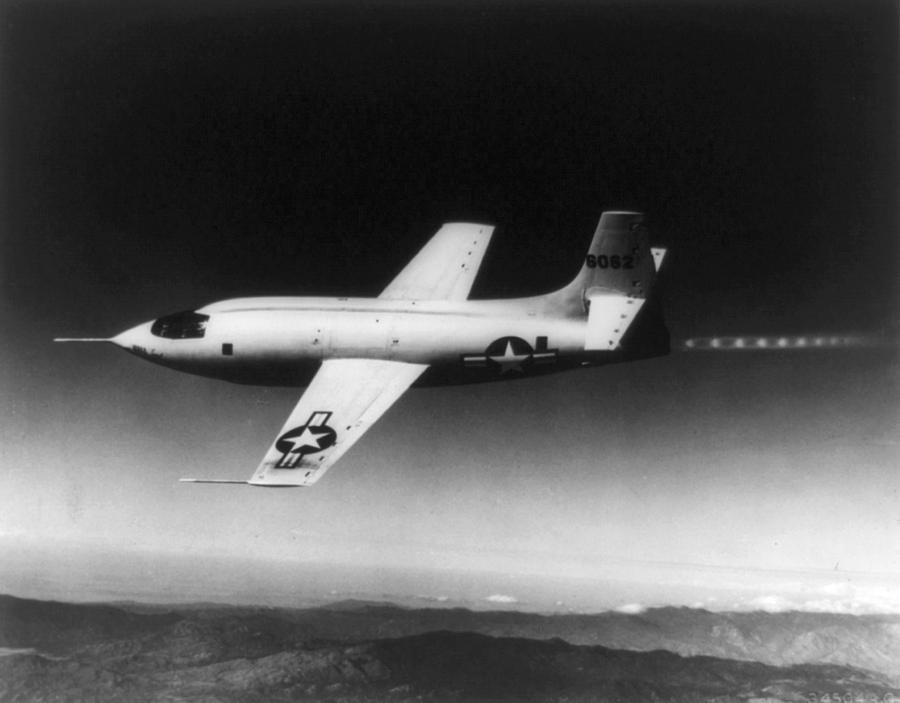
The Bell XS-1, later re-designated X-1, was the first of a series of rocket powered research airplanes which included the Douglas D-558-II Skyrocket, the Bell X-2, and the North American Aviation X-15, which were flown by the U.S. Air Force, U.S. Navy, NACA and its successor, NASA, at Edwards Air Force Base to explore supersonic and hypersonic flight and at altitudes to and beyond the limits of Earth’s atmosphere.
The X-1 is shaped like a bullet and has straight wings and tail surfaces. It is 30 feet, 10.98 inches (9.423 meters) long with a wing span of 28.00 feet (8.534 meters) and overall height of 10 feet, 10.20 inches (3.307 meters). Total wing area is 102.5 square feet ( 9.5 square meters). At its widest point, the diameter of the X-1 fuselage is 4 feet, 7 inches (1.397 meters). The empty weight is 6,784.9 pounds (3,077.6 kilograms), but loaded with propellant, oxidizer and its pilot with his equipment, the weight increased to 13,034 pounds (5,912 kilograms). The X-1 was designed to withstand an ultimate structural load of 18g.
The X-1 is powered by a four-chamber Reaction Motors, Inc., XLR11-RM-3 rocket engine which produced 6,000 pounds of thrust (26,689 Newtons). This engine burns a mixture of ethyl alcohol and water with liquid oxygen. Fuel capacity is 293 gallons (1,109 liters) of water/alcohol and 311 gallons (1,177 liters) of liquid oxygen. The fuel system is pressurized by nitrogen at 1,500 pounds per square inch (10,342 kilopascals).
The X-1 was usually dropped from a B-29 flying at 30,000 feet (9,144 meters) and 345 miles per hour (555 kilometers per hour). It fell as much as 1,000 feet (305 meters) before beginning to climb under its own power.
The X-1’s performance was limited by its fuel capacity. Flying at 50,000 feet (15,240 meters), it could reach 916 miles per hour (1,474 kilometers per hour), but at 70,000 feet (21,336 meters) the maximum speed that could be reached was 898 miles per hour (1,445 kilometers per hour). During a maximum climb, fuel would be exhausted as the X-1 reached 74,800 feet (2,799 meters). The absolute ceiling is 87,750 feet (26,746 meters).
The X-1 had a minimum landing speed of 135 miles per hour (217 kilometers per hour) using 60% flaps.
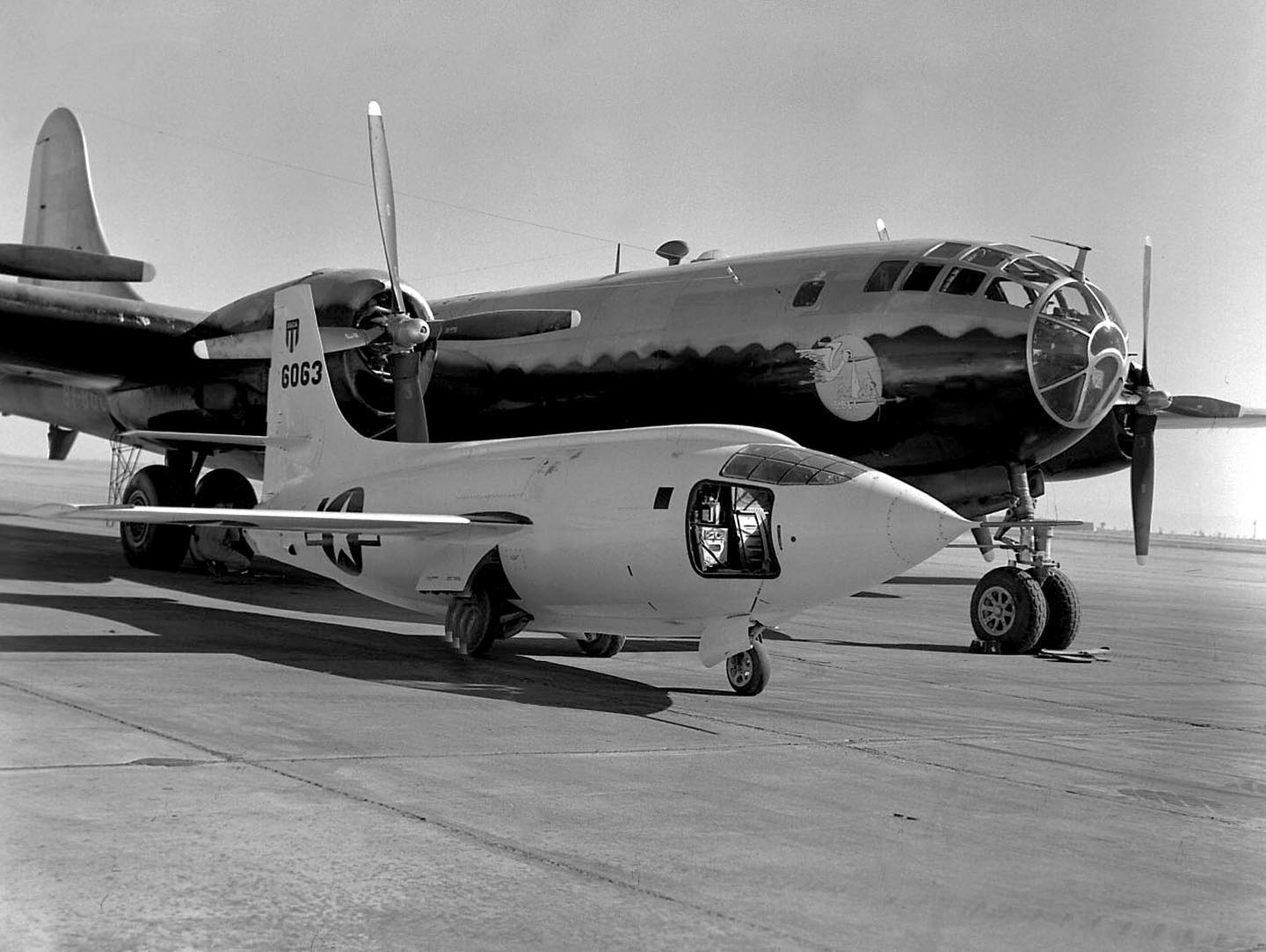
The three X-1 rocketplanes made a total of 157 flights with the three X-1. The number one ship, Glamorous Glennis, made 78 flights. On 26 March 1948, with Chuck Yeager again in the cockpit, it reached reached Mach 1.45 (957 miles per hour/1,540 kilometers per hour) at 71,900 feet (21,915 meters).
The third X-1, 46-064, made just one glide flight before it was destroyed 9 November 1951 in an accidental explosion.
The second X-1, 46-063, was later modified to the X-1E. It is on display at the NASA Dryden Research Center at Edwards Air Force Base.
Glamorous Glennis is on display at the Smithsonian Institution National Air and Space Museum, next to Charles A. Lindbergh’s Spirit of St. Louis.
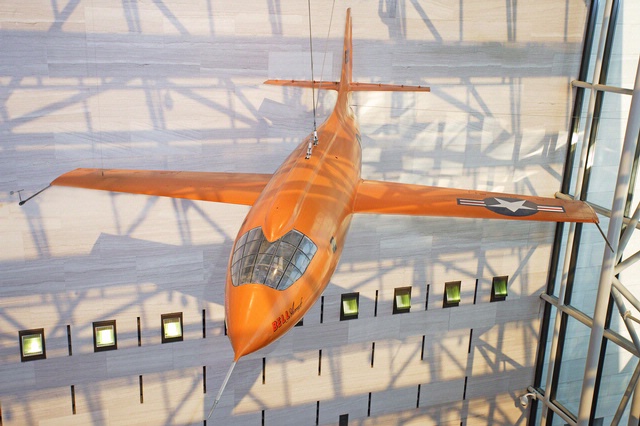
© 2017, Bryan R. Swopes
Another very good blogpost, thank you very much! This is the first good picture of the X-1 Cockpit i see. I first read about Mr. Yeager in Tom Wolfes “The Right Stuff” in my teenager years and was hooked ever since; of course because of the rocket powered flight, which “occured” in our family, too. 😉
BTW: “Yeager” sounds like an anglicised version of the german surname “Jäger” (literally “hunter” in english) – do you know if the Yeagers had german ancestry?
Thank you very much, Hartmut. Yes, Chuck Yeager’s family came from Germany several generations earlier, and in his autobiography he mentions the Jäger connection to his name. I haven’t really research his family background, but if I have time today, I will try to find some more information and re-contact you. . . Thank you for being such a regular reader. Your comments are always informative, and are very much appreciated.
I checked General Yeager’s family tree on Ancestry.com. Going back five generations, his Yeager ancestors were born in America. That was as far back as I could find, so I don’t know how far back in time his ancestors were from Germany. (My own ancestors, then using the name Schwab, emigrated from Sinsheim to Philadelphia in the British colony Province of Pennsylvania, in 1720.)
Thank YOU, Bryan, for your work!
Sinsheim! That´s where the huge museum is, the only one with both original Concorde AND Tu-144. Nice region there, one of the highest living quality in Germany. Thank you very much!
I would like to have visited there, but I fear I am now too old for such a journey.
I was visiting the Smithsonian Steven F. Udar- Hazy Center last week. The Bell X-1 has a new home on the floor behind and to the right of the SR-71. Tried to insert a photo but it didn’t work.
As always, an excellent article. Thanks! A small typo: “Chuck Yeager and flown the XS-1 through…”. The “and” should be “had”?
Thanks, Ben. I made the correction.